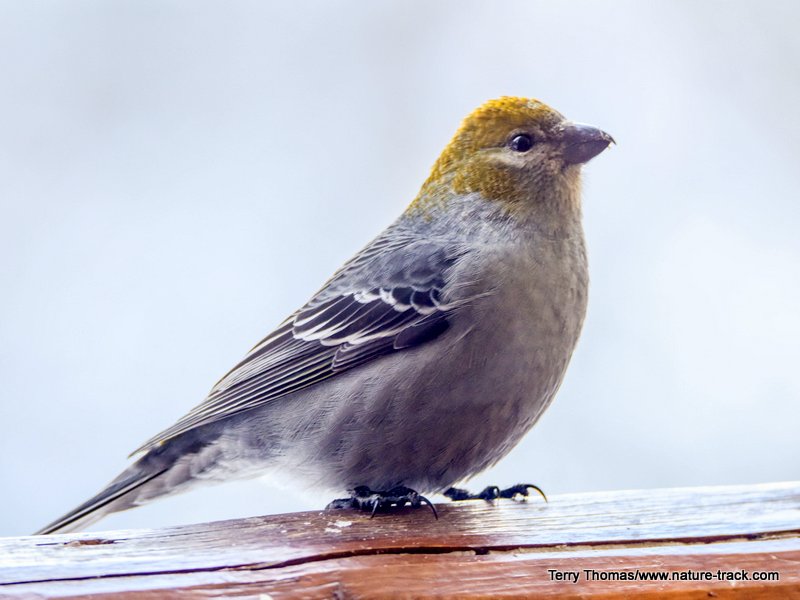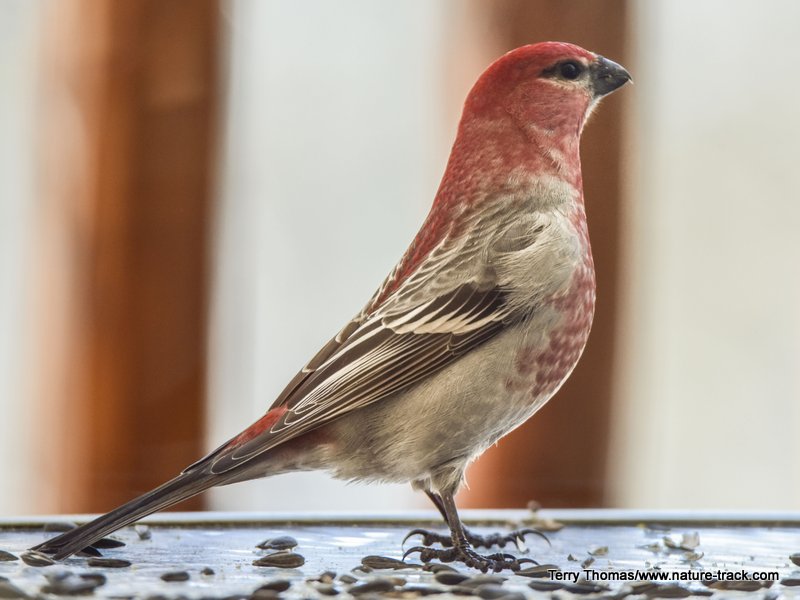Pine Grosbeak


A female pine grosbeak on the left and a male on the right show their respective colors.
When the bears finally go to sleep for the winter, birdfeeders in Island Park come out with a vengeance. At our house, we smear a suet blend on a tree trunk that I move onto our deck and scatter seeds on the picnic table. Peanuts are without a doubt the favorite of all the birds that visit, but black oil sunflower seeds and even seed mixes are eventually consumed.
Our disappointment has been that even though we know there are a number of species that spend the winter here, we routinely only get the same five species: Clark’s nutcracker, Steller’s jay, mountain chickadee, red-breasted nuthatch and hairy woodpecker. Several years ago, Canada jays were common, but it appears that they don’t like the nutcrackers because as nutcracker numbers increased, Canada jay numbers decreased until they stopped coming at all.
I was surprised several weeks ago to see a new bird on the deck rail. It took me a minute to remember what this yellow and gray bird, larger than a house sparrow, was, but then I remembered: a female pine grosbeak. When she flew off, I was sure we had seen the last of the grosbeaks and was sorry that Cathy hadn’t gotten to see it. Several days later though the grosbeak was back with some friends, and now we see them every couple of days. It seems that they like peanuts too.
As the name implies, pine grosbeaks are forest birds, with evergreen trees like fir, spruce, and pine, their preferred habitat. They breed in open conifer forests from California’ Sierra Nevada mountains to Colorado’s Rocky Mountains, up the Rockies to Alaska and across a broad swath of Canada’s boreal forests. They also occur in evergreen forests from Scandinavia to Eastern Asia. It is a patchy distribution that makes them uncommon.
The remainder of their name is a derivation of an old French word, grosbec, meaning, large bill. The bill is short and thick, powerful enough to crack hard seeds and pinch off fresh buds. They are big on fruits of plants such as mountain ash, hawthorn, blackberry, and juniper. During nesting they will consume insects and spiders which they feed to their chicks as a regurgitated paste.
Pine grosbeaks often overwinter in place. However, some will migrate downslope to find stands of maple, juniper, or other foods. Occasionally, an exceptional year of fir cone production will yield an abundant crop of young pine grosbeaks. If the following winter is difficult, these birds may irrupt into places much further south than their normal range.
Pine grosbeaks are the largest northern members of the finch family, dwarfing other finches such as the pine siskin and the house finch. They are the only members of the genus, Pinicola. Females have a yellow head and rump patch surrounded with gray wings, back, chest, and belly. Males are showier, with a pinkish-red covering much of their body and a gray-black wing. Just how much color and how large the birds are depends on location. The largest birds are typically western birds, but color is variable.
Attracting pine grosbeaks, if they are in the area, shouldn’t be all that hard and I probably need to change a few things I am doing. It seems that they like feeders and I just broadcast my sunflower seeds on the table. A hanging feeder might encourage them to visit more frequently. In the longer run, planting berry-producing shrubs like mountain ash would be a good idea. Pine grosbeaks will often camp on a well-supplied bush until all the berries are gone.
Whatever I do, I hope it works and I get to see these interesting birds more frequently.
Help Idaho Wildlife
When we traveled across the state in October 2017, we visited most of the Idaho Department of Fish and Game wildlife management areas. Most of the vehicles we saw using the wildlife management areas did not have wildlife plates. Buying wildlife plates is a great way for non-hunters and hunters alike to support wildlife-based recreation like birding.
C'mon folks, let's help Idaho's wildlife by proudly buying and displaying a wildlife license plate on each of our vehicles!
See below for information on Idaho plates. Most states have wildlife plates so if you live outside Idaho, check with your state's wildlife department or vehicle licensing division for availability of state wildlife plates where you live.
And tell them that you heard about it from Nature-track.com!

Wildlife License Plates
Great news! as of 2024, there are three NEW designs for license plates. They still are bluebird, cutthroat trout and elk, but they are beautiful.
Idaho Wildlife license plates provide essential funding that benefits the great diversity of native plants and wildlife that are not hunted, fished or trapped—over 10,000 species or 98% of Idaho’s species diversity. Game species that share the same habitats (such as elk, deer, antelope, sage-grouse, salmon, trout) also benefit from these specialty plates.
No state tax dollars are provided for wildlife diversity, conservation education and recreation programs. Neither are any revenues from the sale of hunting or fishing licenses spent on nongame species. Instead, these species depend on direct donations, federal grants, fundraising initiatives—and the Idaho Wildlife license plates.
Both my vehicles have Bluebird Plates. I prefer the bluebird because the nongame program gets 70 percent of the money from bluebird plates, but only 60 percent of the money from elk and trout plates - 10 percent of the money from elk plates supports wildlife disease monitoring and testing programs (to benefit the livestock industry) and 10 percent from cutthroat plates supports non-motorized boat access.
Incidentally, in 2014, the Idaho Legislature denied the Department of Fish and Game the ability to add new plates or even to change the name of the elk and cutthroat plates (very specific) to wildlife and fish plates, a move that would have allowed for changing images occasionally and generating more revenue. It would seem that they believe that we Idahoans don't want a well funded wildlife program.
I think it is time we let the Legislature know that Idahoan support wildlife funding and that we would like to see these generic plates come to fruition.

"WOW. What a phenomenal piece you wrote. You are amazing." Jennifer Jackson
That is embarrassing, but actually a fairly typical response to my nature essays. Since The Best of Nature is created from the very best of 16 years of these nature essays published weekly in the Idaho Falls Post Register (online readership 70,000), it is a fine read. It covers a wide variety of topics including humorous glimpses of nature, philosophy, natural history, and conservation. Readers praise the style, breadth of subject matter and my ability to communicate complex and emotional topics in a relaxed and understandable manner.
Everyone can find something to love in this book. From teenagers to octogenarians, from the coffee shop to the school room, these nature essays are widely read and enjoyed.
Some of the essays here are my personal favorites, others seemed to strike a chord with readers. Most have an important message or lesson that will resonate with you. They are written with a goal to simultaneously entertain and educate about the wonderful workings of nature. Some will make you laugh out loud and others will bring a tear to the eye and warm your heart.
Readers Write:
"You hit a home run with your article on, Big Questions in Nature. It should be required reading for everyone who has lost touch with nature...great job!" Joe Chapman
"We enjoyed your column, Bloom Where Planted. Some of the best writing yet. The Post Register is fortunate to have your weekly columns." Lou Griffin.
To read more and to order a copy, click here or get the Kindle version
Copies are also available at:
Post Register
Island Park Builders Supply (upstairs)
Barnes and Noble in Idaho Falls
Harriman State Park, Island Park
Museum of Idaho
Valley Books, Jackson Wyoming
Avocet Corner Bookstore, Bear River National Wildlife Refuge, Brigham City, Utah
Craters of the Moon National Monument Bookstore, Arco, Idaho
Wildlife License Plates
Great news! as of 2024, there are three NEW designs for license plates. They still are bluebird, cutthroat trout and elk, but they are beautiful.
Idaho Wildlife license plates provide essential funding that benefits the great diversity of native plants and wildlife that are not hunted, fished or trapped—over 10,000 species or 98% of Idaho’s species diversity. Game species that share the same habitats (such as elk, deer, antelope, sage-grouse, salmon, trout) also benefit from these specialty plates.
No state tax dollars are provided for wildlife diversity, conservation education and recreation programs. Neither are any revenues from the sale of hunting or fishing licenses spent on nongame species. Instead, these species depend on direct donations, federal grants, fundraising initiatives—and the Idaho Wildlife license plates.
Both my vehicles have Bluebird Plates. I prefer the bluebird because the nongame program gets 70 percent of the money from bluebird plates, but only 60 percent of the money from elk and trout plates - 10 percent of the money from elk plates supports wildlife disease monitoring and testing programs (to benefit the livestock industry) and 10 percent from cutthroat plates supports non-motorized boat access.
Incidentally, in 2014, the Idaho Legislature denied the Department of Fish and Game the ability to add new plates or even to change the name of the elk and cutthroat plates (very specific) to wildlife and fish plates, a move that would have allowed for changing images occasionally and generating more revenue. It would seem that they believe that we Idahoans don't want a well funded wildlife program.
I think it is time we let the Legislature know that Idahoan support wildlife funding and that we would like to see these generic plates come to fruition.